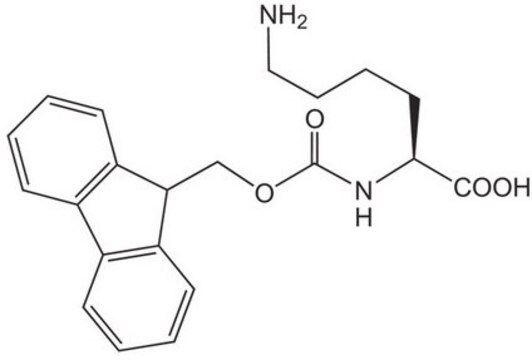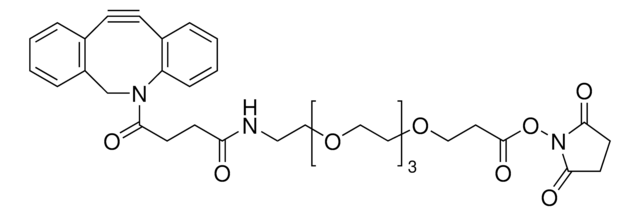QBD10243
Fmoc-N-amido-dPEG®2-acid
>95% (HPLC)
Synonym(s):
Fmoc-N-amido-PEG2-COOH, Fmoc-N-amido-PEG2-acid, Fmoc-PEG-acid, Fmoc-PEG2-acid
Sign Into View Organizational & Contract Pricing
All Photos(1)
About This Item
Empirical Formula (Hill Notation):
C22H25NO6
Molecular Weight:
399.44
MDL number:
UNSPSC Code:
12352106
NACRES:
NA.22
Recommended Products
Assay
>95% (HPLC)
form
solid or viscous liquid
reaction suitability
reaction type: Pegylations
polymer architecture
shape: linear
functionality: homobifunctional
shipped in
ambient
storage temp.
−20°C
Features and Benefits
Fmoc-N-amido-dPEG2-acid is a monodisperse PEG product that is useful for peptide synthesis. The ten-atom dPEG spacer allows the introduction of a short, hydrophilic spacer onto either end of a peptide chain or between two peptide chains. The flexible dPEG spacer conjugates to peptides using conventional peptide synthesis chemistry. Peptide PEGylation imparts water solubility to hydrophobic peptide chains. Also, PEGylated peptides have expanded hydrodynamic volumes, which can reduce or eliminate renal clearance, and are protected from proteolysis. The combination of decreased renal clearance and protection from proteolysis contributes to longer in vivo circulation times for PEGylated (as compared to non-PEGylated) peptides. Additionally, PEGylation diminishes a peptide′s antigenicity. This product is part of the Fmoc-N-amido-dPEGn-acid (n=2, 3, 4, 5, 6, 8, 12, 24, 36) product series.
Legal Information
Products Protected under U.S. Patent #s 7,888,536 & 8,637,711 and European Patent #s 1,594,440 & 2,750,681
dPEG is a registered trademark of Quanta BioDesign
Storage Class Code
11 - Combustible Solids
WGK
WGK 3
Flash Point(F)
Not applicable
Flash Point(C)
Not applicable
Choose from one of the most recent versions:
Certificates of Analysis (COA)
Lot/Batch Number
Sorry, we don't have COAs for this product available online at this time.
If you need assistance, please contact Customer Support.
Already Own This Product?
Find documentation for the products that you have recently purchased in the Document Library.
Aaron S Anderson et al.
Langmuir : the ACS journal of surfaces and colloids, 24(5), 2240-2247 (2008-01-31)
We report a general procedure to prepare functional organic thin films for biological assays on oxide surfaces. Silica surfaces were functionalized by self-assembly of an amine-terminated silane film using both vapor- and solution-phase deposition of 3'-aminopropylmethyldiethoxysilane (APMDES). We found that
Ananda Kumar Kanduluru et al.
Bioconjugate chemistry, 27(9), 2157-2165 (2016-08-17)
The neurokinin-1 receptor (NK1R) is implicated in the growth and metastasis of many tumors, including cancers of the brain (e.g., gliomas, glioblastomas, and astrocytomas), skin (e.g., melanomas), and neuroendocrine tissues (cancers of the breast, stomach, pancreas, larynx, and colon). Because
Jered C Garrison et al.
Bioconjugate chemistry, 19(9), 1803-1812 (2008-08-21)
The high incidence of BB2 receptor (BB2r) expression in various cancers has prompted investigators to pursue the development of BB2r-targeted agents for diagnostic imaging, chemotherapy, and radiotherapy. Development of BB2r-targeted agents, based on the bombesin (BBN) peptide, has largely involved
Ian W Hamley
Biomacromolecules, 15(5), 1543-1559 (2014-04-12)
The remarkable diversity of the self-assembly behavior of PEG-peptides is reviewed, including self-assemblies formed by PEG-peptides with β-sheet and α-helical (coiled-coil) peptide sequences. The modes of self-assembly in solution and in the solid state are discussed. Additionally, applications in bionanotechnology
Our team of scientists has experience in all areas of research including Life Science, Material Science, Chemical Synthesis, Chromatography, Analytical and many others.
Contact Technical Service








